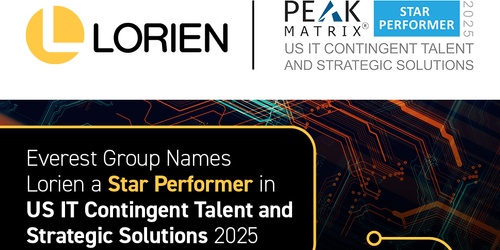While no two organization’s talent development strategies will be identical, the best strategies generally use a multi-stage talent management framework or model. For most companies, this won’t mean reinventing the wheel—at least it shouldn’t—instead, it requires an understanding of the talent life cycle, and accounting for each stage within any talent management strategy or model.
If this sounds like a lot, don’t worry—this might all be easier than you think, especially with the right staffing solution. Keep reading for valuable insights into the different stages of the talent life cycle, how closely they align with the stages of the most commonly used talent development models, and how you can use successful talent management strategy examples to inform your own approach. Let’s jump right in, starting with a quick overview of the talent management life cycle.
What Are the Steps in the Talent Management Life Cycle?
Regardless of industry or company size, the talent management life cycle typically includes at least five key phases, which effectively illustrate the scope of talent management.
Here’s how the Talent Management Institute defines them:
-
Recruitment and Attraction: This stage of the talent life cycle mainly consists of assessing the organization’s talent needs, setting priorities, and engaging with recruiters or hiring partners to help identify and attract high-quality talent.
-
Hiring and Onboarding: This includes hiring the right people, and onboarding them effectively, empowering new hires to hit the ground running in a way that feels empowering and supportive. Onboarding processes should also include activities to help acclimate new employees to the organization, including its workplace expectations, how it defines its culture, and where they can turn for support as they get to business.
-
Performance Management: Once onboarding processes conclude, the focus transitions from informing employees about their roles and responsibilities to managing their performance within those roles. This might be done on an individual, departmental, or board organizational level, but what’s most important is setting measurable and meaningful objectives—and effectively coaching employees toward success.
-
Employee Development: Closely related to performance management, employee development primarily involves things like coaching, training, and mentoring—activities meant to grow employees’ skill sets and help them chart a path toward achieving their own career objectives.
-
Employee Retention: If you have much experience with staffing or talent management, you’re probably already aware of this, but retaining existing employees is generally much more cost-effective than replacing them with new hires.
Depending on who you ask, many organization’s talent management life cycles also include a sixth component, succession planning. Unlike the five steps outlined above, succession planning relates to what happens in both the short- and long-term once a talent development process model has been developed and put into action. Succession planning includes identifying internal candidates for filling talent vacancies and determining when the right time might be to recruit new employees, effectively re-starting the talent life cycle.
What Are the 7 Stages of Talent Management Model Creation and Implementation?
As mentioned in the previous section, the different components of the talent life cycle framework should inform your approach to creating an effective talent development model that will work for your organization. So, how do you create a talent management model that works? Next, let’s break the talent management process into seven steps or stages.
Stage #1: Needs Assessment and Solutions Consideration
Before even thinking about candidate recruitment and attraction, the first thing you’ll need to do is determine your actual staffing needs. This often means reviewing the company’s short- and long-term objectives and then prioritizing the resources and personnel required to achieve those objectives. In many cases, this may begin with an internal skills audit to better understand the current skills gaps, so they can be appropriately prioritized throughout the recruitment and attraction processes.
It’s during this stage that many companies realize that the data available to them is not as actionable, reliable, or complete as they may have thought. As a result, hiring managers might struggle to really understand the current talent landscape—in turn, making it more difficult for them to set the right expectations and objectives related to staffing.
During this phase, it’s important to be flexible and open-minded, and to consider a wide range of staffing solutions. If you’re not sure what approach or approaches might be best for your company, working with an agency like Lorien can be a game-changer. At Lorien, we offer several business solutions, including:
Stage #2: Recruitment and Attraction
There are several different approaches to talent recruitment, each with its own advantages and disadvantages (depending on what you hope to achieve). While many companies might prefer to handle every aspect of talent management internally, working with a staffing agency (like Lorien) is often a more efficient and effective way to find, hire, and retain the best available talent. Whether you need contracted or permanent hires, project- or contingency-based workers, or a combination of workforce types, we’ll help you find the right solutions for your needs.
Stage #3: Hiring and Onboarding
When new employees come aboard, leadership only gets one real shot at making the kind of first impression that’s going to energize and inspire new hires. You can learn a lot by asking existing employees what they remember about their own onboarding, including what worked and didn’t work in their opinion. With a better understanding of what new hires are likely to expect—and how they view current processes—companies can make the necessary improvements over time.
Stage #4: Performance Management
As it relates to the development of talent management strategies, performance management is essential. The best way to be successful here is to identify the metrics or key performance indicators that matter most, communicate their importance, and then use them to monitor employee performance. You won’t want to micromanage here, but meaningful accountability—and coaching to improvement—is what matters most.
Stage #5 Employee Development
Closely related to performance management, employee development primarily involves things like coaching, training, and mentoring—activities meant to grow employees’ skill sets and help them chart a path toward achieving their own career objectives. Here, it’s not just important to support and encourage meaningful development, but to make sure everyone in the organization understands the type of career development available to them.
Stage #6: Employee Retention
As we’ve noted, retaining employees is much more cost-effective than replacing existing employees with new hires. The best talent development models account for this reality, making sure that the end-to-end talent management process is consistent and geared toward empowering employees in a way that makes them want to stick around and keep contributing their best work.
Stage #7: Succession Planning
Over time, you can fine-tune your approach to talent management, and it will become easier for the hiring organization to make the right staffing decisions. One of the biggest benefits of having effective talent management models in place is the increased ability to develop employees in a way that prepares them for increased roles and responsibilities. That way, when critical vacancies emerge, the company can move quickly to fill that position via internal candidates, saving a lot of time, money, and energy over traditional recruitment techniques.
Optimize Your Talent Management with Lorien
At this point, we don’t need to explain the importance of talent management—or the impact getting it right can have on your ability to properly keep your organization staffed with the right talent at the right time. Leveraging the right business solution (or solutions) for your company’s staffing needs greatly enhances your ability to remain productive, innovative, and competitive.
At Lorien, our team of experts would love to discuss your staffing needs and explore how we can support your efforts with our wide range of permanent, contingent, and other workforce solutions. You can visit our website to learn more about our expert team, or reach out directly to start the conversation today!








